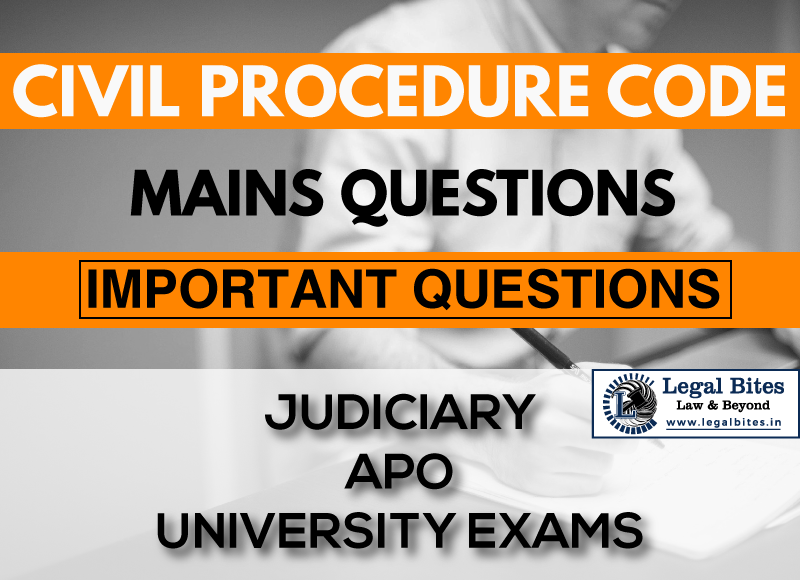'A’ files a plaint in the court of Munsif, Jaipur. The Munsif finds that the plaint does not disclose any cause of action. What order should be passed by Munsif, Jaipur in this case? Give relevant provisions.
Find the answer to the mains question only on Legal Bites.

Question: ‘A’ files a plaint in the court of Munsif, Jaipur. The Munsif finds that the plaint does not disclose any cause of action. What order should be passed by Munsif, Jaipur in this case? Give relevant provisions. [HP HJS 2003, UPHJS1996] Find the answer to the mains question only on Legal Bites. ['A’ files a plaint in the court of Munsif, Jaipur. The Munsif finds that the plaint does not disclose any cause of action. What order should be passed by Munsif, Jaipur in this case?...
Question: ‘A’ files a plaint in the court of Munsif, Jaipur. The Munsif finds that the plaint does not disclose any cause of action. What order should be passed by Munsif, Jaipur in this case? Give relevant provisions. [HP HJS 2003, UPHJS1996]
Find the answer to the mains question only on Legal Bites. ['A’ files a plaint in the court of Munsif, Jaipur. The Munsif finds that the plaint does not disclose any cause of action. What order should be passed by Munsif, Jaipur in this case? Give relevant provisions.]
Answer
Munsif, Jaipur should reject the plaint filed by 'A'- Order VII, Rule 11 (Rejection of plaint).
Order VII of Civil Procedure Code deals with provisions relating to a 'Plaint'. Order VII Rule 11 of the Code of Civil Procedure elaborates on the rejection of plaints in certain circumstances. It has mentioned certain grounds on the basis of which the plaints are rejected by the courts. One of them is not mentioning the cause of action that the plaintiff seeks against the respondent.
It is necessary to decide the application of rejection of the plaint under Order VII. Rule 11 of Order VII lays down the circumstances under which the court should reject the plaint. Order VII, Rule 11(a) speaks that a plaint shall be rejected if it does not disclose a cause of action.
A plaint can be rejected by the court if it does not mention a cause of action which is to be taken by the plaintiff against the respondent. It is perceived as an abuse of the process of the court. The cause of action has been mentioned in various places in the Code of Civil Procedure. Without a cause of action, a civil suit cannot arise. The cause of action is necessary because it discloses the facts that led the plaintiff to take such action. When the plaint is rejected, the court needs to just look at the plaint and nothing else.
The Hon’ble Supreme Court in the case of Church of Christ Charitable Trust v. M/S. Ponniamman Educational Trust, (2012) made the observation that the cause of action is essential for the plaintiff to prove in order to succeed in the suit. Thus, a plaint that does not reveal/disclose the cause of action has no scope of succeeding and, thus, must be dismissed.
In the present case at hand, the plaint filed by 'A' in the court of Munsif, Jaipur does not disclose any cause of action. Thus, Munsif, Jaipur should reject the plaint filed by 'A' in view of the provisions made in Order VII, Rule 11(c) of the Civil Procedure Code.
Important Mains Questions Series for Judiciary, APO & University Exams
- CPC Mains Questions Series: Important Questions Part – I of X
- CPC Mains Questions Series: Important Questions Part – II of X
- CPC Mains Questions Series: Important Questions Part – III of X
- CPC Mains Questions Series: Important Questions Part – IV of X
- CPC Mains Questions Series: Important Questions Part – V of X
- CPC Mains Questions Series: Important Questions Part – VI of X
- CPC Mains Questions Series: Important Questions Part – VII of X
- CPC Mains Questions Series: Important Questions Part – VIII of X
- CPC Mains Questions Series: Important Questions Part – IX of X
- CPC Mains Questions Series: Important Questions Part – X of X

Mayank Shekhar
Mayank is an alumnus of the prestigious Faculty of Law, Delhi University. Under his leadership, Legal Bites has been researching and developing resources through blogging, educational resources, competitions, and seminars.
